In Sn1 Reactions the Intermediate Carbocations Can Eliminate
7.9: Characteristics of the Sₙ1 Reaction
- Page ID
- 45179
Learning Objective
- decide the rate law & predict the mechanism based on its rate equation or reaction information for S N ane reactions
- predict the products and specify the reagents for Due south N 1 reactions with stereochemistry
- propose mechanisms for Southward Northward one reactions
- draw and interpret Reaction Energy Diagrams for S North 1 reactions
In order of decreasing importance, the factors impacting SNorthward1 reaction pathways are
- structure of the alkyl halide
- stability of the leaving group
- type of solvent.
The unimolecular transition state of the SouthNone pathway means that structure of the alkyl halide and stability of the leaving group are the primary considerations. Alkyl halides that can ionize to form stable carbocations are more reactive via the Due southN1 mechanism. Because carbocation stability is the primary energetic consideration, stabilization of the carbocation via solvation is also an important consideration.
Alkyl Halide Structure and Carbocation Stability
The first gild kinetics of SN1 reactions suggest a two-step mechanism in which the rate-determining step consists of carbocation formation from the ionization of the alkyl halide as shown in the diagram below. In this machinery, the carbocation is a high-free energy intermediate the bonds immediately to nearby nucleophiles. The only reactant that is undergoing change in the first (charge per unit-determining) step is the alkyl halide, so we expect such reactions would exist unimolecular a nd follow a first-order charge per unit equation. Hence the proper noun SouthwardNone is practical to this mechanism.
The Hammond postulate suggests that the activation energy of the charge per unit-determining first step will be inversely proportional to the stability of the carbocation intermediate: the more stable the carbocation, the lower the activation energy, the faster the reactivity. Therefore, carbocation stability is a master consideration in SNane reactions. Carbocations can be stabilized by delocalizing the charge via resonance and through inductive electron donation of alkyl groups. Carbocations tin likewise stabilize past rearrangement via 1,ii-hydride or one,2-methyl shifts. Carbocation rearrangements are explained in a subsequent section of this chapter.

Benzyl Carbocation

The relative stability of carbocations is summarized below.

| Carbocation Stability | CH3 (+) | < | CH3CHii (+) | < | (CHiii)iiCH(+) | ≈ | CHtwo=CH-CH2 (+) | < | C6H5CH2 (+) | ≈ | (CH3)3C(+) |
Consequently, we expect that 3º-alkyl halides will be more reactive than their 2º and 1º-counterparts in reactions that follow an SNane mechanism. This is reverse to the reactivity club observed for the SouthwardN2 mechanism. Allylic and benzylic halides are exceptionally reactive by either mechanism. This trend is summarized in the diagram below.

Furnishings of Leaving Group
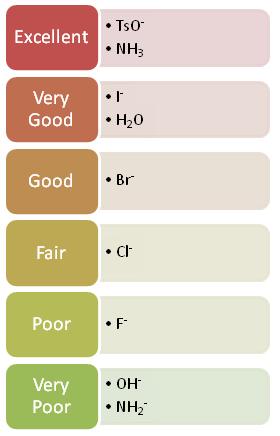
An SN1 reaction speeds up with a good leaving group. This is considering the leaving group is involved in the charge per unit-determining step. A good leaving grouping wants to exit so it breaks the C-Leaving Grouping bail faster. One time the bond breaks, the carbocation is formed and the faster the carbocation is formed, the faster the nucleophile can come in and the faster the reaction volition be completed.
A adept leaving group is a weak base because weak bases tin concord the charge. They're happy to leave with both electrons and in society for the leaving group to exit, it needs to exist able to take electrons. Strong bases, on the other mitt, donate electrons which is why they tin can't be adept leaving groups. As y'all go from left to right on the periodic table, electron donating ability decreases and thus ability to exist a good leaving group increases. Halides are an example of a proficient leaving group whos leaving-grouping power increases as you go downwards the column.
.jpg?revision=1&size=bestfit&width=300&height=74)
The ii reactions below is the same reaction washed with 2 different leaving groups. One is significantly faster than the other. This is considering the better leaving group leaves faster and thus the reaction can keep faster.

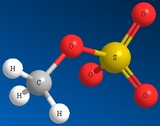
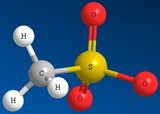
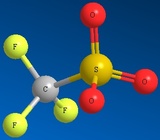
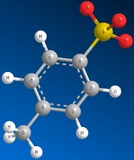
Methyl Sulfate Ion Mesylate Ion Triflate Ion Tosylate Ion
CH3And theniv ii- CH3And so3 2- CF3Then3 2- CH3C6H4SO3 2-
Solvent Furnishings on the SouthwardN1 Reaction
To facilitate the charge separation of the ionization reaction in the first stride, a good ionizing solvent is needed. Ii solvent characteristics volition exist particularly of import - the polarity and the solvating power. The dielectric constant, ε, measures polarity of solvent molecules and their ability to orient themselves between ions to benumb (reduce) the electrostatic forcefulness 1 ion exerts on the other. T he higher the dielectric constant the more polar the substance and in the case of SN1 reactions, the faster the rate. A dielectric abiding below 15 is usually considered non-polar. Solvents having high dielectric constants, such as water (ε=81), formic acid (ε=58), dimethyl sulfoxide (ε=45) & acetonitrile (ε=39) are by and large considered better ionizing solvents than are some common organic solvents such every bit ethanol (ε=25), acetone (ε=21), methylene chloride (ε=9) & ether (ε=4). Below is the same reaction conducted in two dissimilar solvents. The relative reaction rate in water (ε=81) is 150,000 times faster than in methanol (ε=33) .
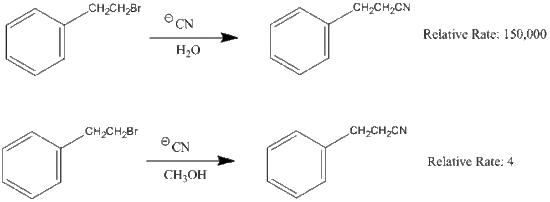
Solvation refers to the solvent'southward ability to stabilize ions past encasing them in a sheath of weakly bonded solvent molecules. Anions are solvated by fractional positive charges of hydrogen-bonding solvents. Cations are often best solvated past the nucleophilic sites on a solvent molecule (e.g. oxygen & nitrogen atoms). The interaction of the carbocations with these nucleophilic solvents may be strong plenty to grade covalent bonds to carbon, thus converting the intermediate to a exchange product and creating the reaction name "solvolysis". When solvolysis occurs with water, the actions are called "hydrolysis reactions" as shown in the reaction below.

Polar Protic and Polar Aprotic Solvents
Protic solvents contain polarized hydrogen. Whereas, aprotic solvents do Not contain polarized hydrogen. For Due southNorthii reactions, solvation of the nucleophile by polar protic solvents slows the reaction rate. However, in SN1 reaction the nucleophile is non a part of the rate-determining step then this business is non relevant. In fact, polar protic solvents actually speed up the rate of SN1 reactions because the polar solvent helps stabilize the transition land and carbocation intermediate. Since the carbocation is unstable, anything that can stabilize this even a little will speed up the reaction. Polar aprotic solvents have a dipole moment, simply their hydrogen is not highly polarized. Polar aprotic solvents are not used in SN1 reactions because some of them tin can react with the carbocation intermediate and give an unwanted side-product. Rather, polar protic solvents are preferred for unimolecular substitution reactions.
Effects of Nucleophile
The strength of the nucleophile does not affect the reaction charge per unit of SouthwardNi because the nucleophile is not involved in the rate-determining step. Since nucleophiles simply participate in the fast second step, their relative molar concentrations rather than their nucleophilicities should exist the chief product-determining factor. If a nucleophilic solvent such as water is used, its loftier concentration will assure that alcohols are the major product. Nonetheless, if yous accept more than one nucleophile competing to bond to the carbocation, the strengths and concentrations of those nucleophiles affects the distribution of products. For example, if t-butylchloride reacts with a mixture of water and formic acid where the water and formic acid are competing nucleophiles, two dissimilar products are formed: (CHiii)3COH and (CHthree)iiiCOCOH. The relative yields of these products depends on the concentrations and relative reactivities of the nucleophiles. With a higher electron density, water is considered the stronger nucleophile and the tertiary alcohol will be the major product if there are equal concentrations of competing nucleophiles.
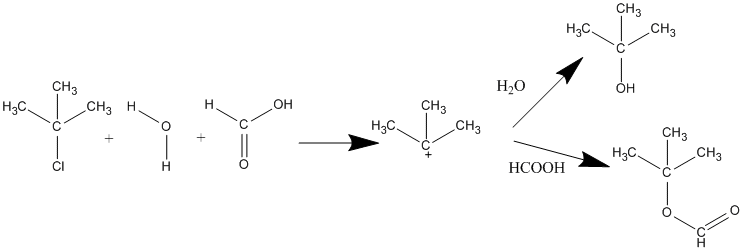
Exercises
ane. Rank the following by increasing reactivity in an SNone reaction.

2. iii-bromo-1-pentene and one-bromo-2-pentene undergo Due southDue north1 reaction at almost the same charge per unit, only one is a secondary halide while the other is a primary halide. Explicate why this is.
3. Label the following reactions as most probable occuring by an SouthwardN1 or SouthN2 machinery. Suggest why.
.png?revision=1)
- Answers
-
1. Consider the stability of the intermediate, the carbocation.
A < D < B < C (most reactive)
2. They have the same intermediates when you expect at the resonance forms.
.png?revision=1)
iii. A – SNane *poor leaving group, protic solvent, secondary cation intermediate
B – SNorthwardii *good leaving grouping, polar solvent, primary position.
Source: https://chem.libretexts.org/Bookshelves/Organic_Chemistry/Map:_Organic_Chemistry_%28Wade%29/07:_Alkyl_Halides:_Nucleophilic_Substitution_and_Elimination/7.09:_Characteristics_of_the_S%E2%82%991_Reaction
Belum ada Komentar untuk "In Sn1 Reactions the Intermediate Carbocations Can Eliminate"
Posting Komentar